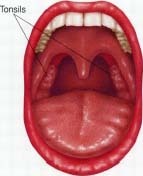Tonsillitis
Tonsillitis is an infection of the tonsils, which are lumps of tissue located at the back of the mouth near the opening of the throat.
KEYWORDS
for searching the Internet and other reference sources
Inflammation
Otolaryngology
Palatine tonsils
Respiratory system
Until recent decades, the removal of tonsils was very common in child-hood. Many adults today recall the unlimited ice cream they were given to soothe throat pain after surgery. Today, it is uncommon to remove the tonsils unless they become infected repeatedly or are large enough to obstruct breathing.
What Is Tonsillitis?
The tonsils are collections of lymphatic tissue * involved in helping the body to prevent and fight infection. Sometimes, however, the tonsils themselves become infected with viruses or bacteria. The tonsils swell and sometimes become coated with whitish spots or pus. This commonly happens with pharyngitis * , influenza, or other respiratory * infections.
The first symptom of tonsillitis is usually a sore throat. Fever and chills may follow, and the lymph nodes (glands) under the jaw and in the neck may become swollen and sore. Tiredness and loss of appetite are common. Swallowing may become difficult. Sometimes there is also a middle ear infection, because the eustachian (yoo-STAY-ke-an) tube, which connects the throat and middle ear, becomes blocked.
Who Gets Tonsillitis?
Tonsillitis can happen to anyone, but it is more common in children. A doctor will try to determine whether a virus or a bacterium is causing the tonsillitis. A cotton swab is touched to the tonsillar area and used to test for the presence of streptococci bacteria, which cause strep throat and can be killed with antibiotics. If, however, a virus is causing the ton-sillitis, then antibiotics will not work. The body's own defenses must fight the virus.
A non-aspirin pain reliever can lessen soreness in the throat. Soft food, soups, milkshakes, and ice pops also help. Getting adequate rest is important, as is drinking enough liquid. Most people start to feel better within five days after the sore throat starts. It might take longer if the tonsillitis is the result of a viral infection.
* lymphatic tissue is tissue where white blood cells fight invading germs.
* pharyngitis (far-in-JY-tis) is a sore throat.
* respiratory (RES-pi-ra-tor-ee) refers to the breathing passages and lungs.

Can Tonsillitis Be Prevented?
The best way to avoid a bout of tonsillitis is to avoid close contact with people who have respiratory infections. This is especially important for people who have had tonsillitis before. It is important not to share cups or utensils with people who have sore throats or who are coughing and sneezing. It is always important to wash the hands frequently to help prevent the spread of this and other infections.
Will the Doctor Cut Out the Problem?
Recurrent bouts of tonsillitis may cause a doctor to recommend ton-sillectomy (ton-si-LEK-to-mee), which means surgery to remove the tonsils. Often, the surgeon removes the adenoids (also lymphatic tissue near the tonsils) at the same time. Surgery may be considered when a child has had many infections. This surgery was common for many years, although today it is done less frequently. In some cases, the tonsils are removed to help people with sleep apnea, which is a disorder that causes breathing to stop for brief periods during sleep.
See also
Ear infections
Sleep Apnea
Strep Throat
Comment about this article, ask questions, or add new information about this topic: